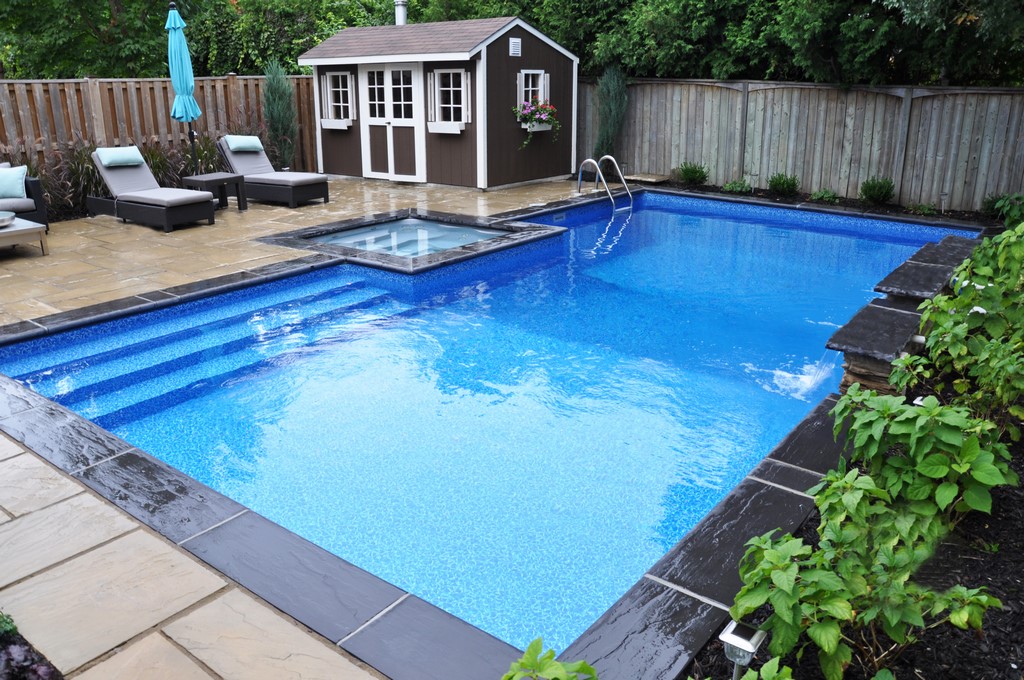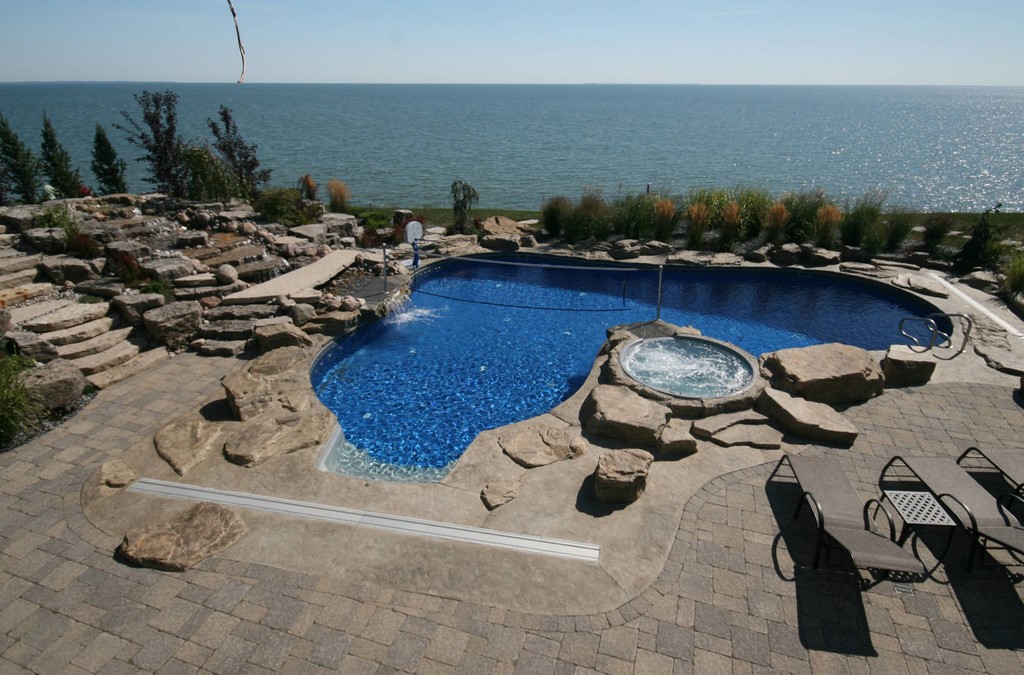A Fuller Experience

I’d hazard the guess that most experienced pool designers and builders have run into this scenario: The clients want a pool, and they also want a spa – but not just any spa will do.
Through the years, these clients have been in the attached spas of friends’ inground concrete pools, but this is not what they want. That’s because they’ve also experienced portable spas and prefer their performance: superior jet action, diverse seating arrays and options, more features and a different, cut-above level of hydrotherapy and relaxation.
Resolving this occasional client preference has always been an issue with concrete pools, but it’s also something that’s coming up with greater frequency in conversations about vinyl-liner pools (which we’ll focus on here): To complete a backyard oasis while delivering what these clients want involves some creativity on the part of the designer and builder – and a basic understanding of how pre-engineered, fully fabricated spas work and interface with pool systems.
THE DROP-IN OPTION
Of course, there’s always the possibility of providing these clients with a portable spa they can place on a deck near the pool, but for the most part this is set aside as an unsatisfying solution, mainly for aesthetic reasons. What few consider is that it’s also a practical matter: With a portable spa and pool side by side, there are two separate systems, two consumers of energy and two bodies of water that need to be treated and maintained.
Better all the way around is a pre-engineered poolside spa that can be fully integrated into the pool system in the form of what we at Fox Pool Corp./Fabcote (York, Pa.) call a “drop-in spa.” Obviously, there’s more to this approach than digging a hole and literally dropping a spa into place: In fact, it’s a bit like installing a second, smaller pool – an operation that requires as much care and consideration as installing the larger adjacent vessel.
In preparing the space for the spa, for example, it’s important to pay close attention to the soil, which should ideally be sandy with plenty of natural drainage. If that’s not the case and the soil is instead a heavy clay, for example, it’s essential to install a drainage system beneath the spa to carry away excess water. If that water is allowed to collect, chances are increased that the spa will move and can even pop out of the ground.
| Dropping a prefabricated spa into a deck is relatively simple, but it does require careful site preparation to ensure adequate drainage as well as full support at the spa’s footwell (left). The resulting plumbing systems can be simple as well if the spa features a limited number of jets (middle). With big, multi-jet spas, however, the multiple pumps and water routes can make the pipe-and-valve networks quite intense (right). |
Drainage-system design is especially important in freeze/thaw areas, where sewers and piping systems often get clogged in the spring as winter ice melts. Your clients may be accustomed to a bit of basement flooding if drainage is already and issue, but having their spa rise up out of the ground, breaking pipes and fittings as it moves? That’s a different story – and one you can avoid ever having to hear with a few simple precautions.
First, set the sub-spa drainage system up properly and place it deep enough that it travels to waste below the frost line. Second, advise your clients not to empty the spa in winter the way they might empty a fountain or some other small waterfeature. By dropping in a plastic liner and filling the spa to near-operating level, the weight of the water inside the spa will equalize the pressure applied by intruding groundwater and keep the spa in place.
But note: In preparing the ground below the spa for installation, be absolutely certain that the set-up for the drainage system still allows the spa to be entirely supported by the footwell: If it ends up being supported only by the lip of the spa, it’s more than likely that the lip will flare and ultimately crack!
SYSTEM INTEGRATION
The easiest way to think about tying the pool and spa systems together is to consider them as two pools, side by side – one small and the other large.
The nice thing about adding a spa to the equation is that it usually doesn’t require complete rethinking of the equipment pad. In fact, all it usually takes is the inclusion of two three-way valves, one in front of the pump to control whether suction comes from the pool or spa, the other installed after the heater to divert water to either vessel.
Things get a bit more complicated if the design decision is made to elevate the spa above pool level to create a spillway or waterfall effect. In these cases, you must install an in-line check valve in the return line directed to the spa. This check valve will prevent the backflow of water from the spa to the pool when the system is turned off while in the waterfall/overflow position.
If the spa being installed has a small jet array – say, up to a dozen jets in all – then the system described just above, with the addition of a couple of three-way valves and maybe a check valve to an equipment pad that runs perfectly well with just one pump, will be more than adequate to the purpose.
| Some clients pursue designs that leave the spa’s lip exposed. This might be an aesthetic compromise to some eyes, but the full-featured performance of these prefabricated spas is a strong compensating factor. |
All that’s involved here is familiarity with the way three-port valves work, with one pathway serving the pool, the other serving the spa. The only hurdle here is keeping the pipes straight so that the two valves work in unison when turned from position to position.
But what happens if the client wants lots of bells and whistles and a spa that features two dozen jets or even more? When this situation arises, one pool pump will not be enough and a booster pump will be needed on the pad. That requirement is made physically obvious by the way these jet-rich spas show up on site: They’ll come with dual suction and return lines, all rigged with two-inch fittings that are critical to overall flow patterns and performance.
The suction line attached to the skimmer canister in the spa must be connected to the suction of the booster pump, while the return line from the booster pump flows to side of the spa with the spa’s main diverter valve. This plumbing configuration will allow water from both pumps to be filtered and treated. It also offers maximum water flow with less restriction to the side of the spa with the most jets.
Valve positions are important, because you want to set them up in such a way that, when the spa is not in use, water still flows through the smaller vessel and therefore stays clean and treated. This means setting up the valves with the diverter placed equally between the two extremes so water from each side is mixed.
It’s a bit different with spillover spas, because you want enough water flowing into the smaller vessel to keep it flowing into the larger vessel at the desired rate whenever the circulation system is activated. But keep the flow to a minimum: The pool is designed to self-clean via predictable water movement, and if you divert too much water to the spillover spa, the pool’s circulation patterns may suffer.
PRACTICALITIES
Generally speaking, pool and spa equipment is located away from these watershapes so the noises it makes don’t interfere with gracious poolside living. These days, some pool systems are still manually controlled – but more and more of them are controlled remotely, which is great.
If manual control is the choice, getting clients ready to use their new pool/spa combination requires some educating in the use of their valves. It’s amazing how often only one valve gets turned, for example, or the homeowner will fail to return the valves to ordinary operating positions after using the spa. In some cases, these mistakes can result in the spa being either flooded or completely emptied – not desirable outcomes!
This is why we strongly advocate the installation of automated control systems that take matters such as proper valve pairings and alignments out of the hands of homeowners. It generally doesn’t take much to familiarize them with controllers, and the costs are more than compensated for by ease of use, convenience and peace of mind.
| In these cases, the true, manufactured nature of the spas has been masked by decorative coping, stonework or brickwork. You need to get up close to see that these aren’t conventional attached spas, and it’s also true that they can easily be set at some distance from their companion pools. |
As was suggested at the start of this article, aesthetics are a key factor in the success of adding a spa to a pool package. These spas can be placed at any point around a pool’s perimeter, but it’s important to consider what the addition will look like from various points of view around the pool and from inside the home. It’s also worthwhile to consider what bathers will see while seated inside the spa.
One key distinction between pools and spas is that spas need to be placed closer to the equipment pad than is generally the case with pools. The best range is within about 25 or maybe 30 feet at the outside: Beyond that, jet performance can suffer, particularly for big, 25-jet spas filled with bathers using every jet. Variable-speed pumps are a true asset these days: Because they operate so much more quietly than do conventional pumps, it’s possible to place them closer to the watershapes without creating an unwanted distraction.
One last design consideration: For clients who want to use their spas year ’round (or close to it), it’s best to opt away from a spillover spa. Water will be displaced every time the spa is used in wintertime, which will leave homeowners with the chore of refilling the spa manually so long as the adjacent pool is closed for the season.
Speaking of winter, as was mentioned above, it’s advisable to leave the spa at least partially filled with water through the winter to weigh it down and counteract hydrostatic pressure. Lining the spa with plastic after draining the lines and before refilling will prevent the creation of a dirt- and mineral-crusted “waterline” that will have to be dealt with when Spring comes around.
RIDING THE TREND
With more and more homeowners looking to create complete backyard wonderlands, it’s natural that drop-in spas, completely pre-plumbed and ready for installation, are being added not only to vinyl-liner pools, but also to fiberglass or concrete pools where clients want maximum spa performance and features as part of the package.
As with the pool itself, the addition of these spas takes design skill as well as practical knowledge of how these systems work, whether they’re to be controlled manually or through use of automated valves and digital interfaces.
The clients for these full-featured backyards have great expectations and won’t settle for less than excellence – all of which can be delivered to their complete satisfaction by dropping a fully engineered, fully tested spa into the deck alongside the pool.
It’s a simple marriage, and heavenly as well.
Dave Hoffman is the national service manager for Fox Pools/Fabcote, a manufacturer of package pools and spas based in York, Pa. Hoffman has more than 35 years’ experience in helping pool builders with pool and spa projects and may be reached at dhoffman@foxpool.com.





















